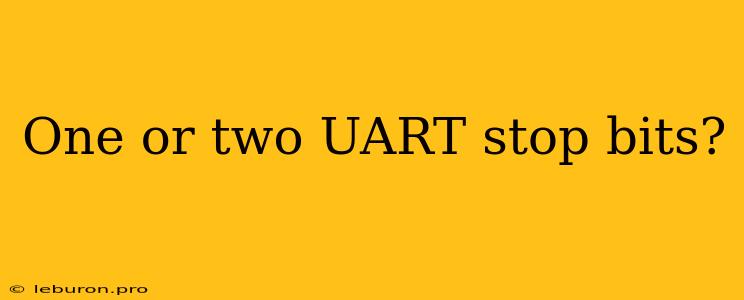The choice between one or two stop bits in a UART communication can significantly impact data integrity and overall system performance. Understanding the differences and implications of these settings is crucial for effective serial communication design. This article delves into the fundamental concepts of stop bits, their impact on data transmission, and the factors that influence the decision between one or two stop bits.
The Role of Stop Bits in UART Communication
UART (Universal Asynchronous Receiver/Transmitter) is a widely used serial communication protocol that allows data exchange between devices. In essence, it converts parallel data into a serial stream of bits for transmission over a single wire. To ensure reliable data transfer, UART communication utilizes specific start and stop bits.
Stop bits are essential for synchronizing the communication between the transmitting and receiving devices. They signal the end of a transmitted data frame, allowing the receiver to identify the boundaries of each character. The receiver uses the stop bits to recognize the end of a complete data frame, ensuring that the next character is correctly received.
One Stop Bit: The Basic Configuration
The most common configuration for UART communication is using one stop bit. This configuration is typically employed in asynchronous data transmission, where the timing of the data is not synchronized between the transmitting and receiving devices. The transmitter transmits data at a constant rate, and the receiver needs to determine the start and end of each character. The stop bit serves as a clear indication of the character's end.
Two Stop Bits: Enhancing Data Integrity
Using two stop bits offers an advantage in terms of data integrity. The presence of two stop bits increases the time gap between the end of one character and the start of the next character. This increased gap offers a buffer, reducing the risk of misinterpretation due to timing discrepancies or noise in the communication channel. The receiver has more time to recognize the stop bit sequence and prepare for the next character.
Factors Influencing the Stop Bit Choice
While two stop bits offer enhanced reliability, the decision to utilize them depends on various factors:
Data Rate:
- At higher data rates, the time between characters is shorter. This makes the increased gap provided by two stop bits even more beneficial in ensuring reliable data reception.
Noise Sensitivity:
- If the communication channel is prone to noise, using two stop bits can mitigate the impact of noise by providing a longer stop bit period, giving the receiver a better chance to distinguish the stop bits from noise.
Hardware Limitations:
- Some UART implementations may not support two stop bits, or the hardware may require additional configuration to enable this setting.
Compatibility:
- Compatibility with other devices is crucial. Ensure that both the transmitting and receiving devices support the chosen stop bit configuration.
Consequences of Using the Wrong Stop Bit Setting
Using the wrong stop bit setting can lead to communication errors, rendering the data unusable.
Incorrect Character Detection:
- If the receiver expects one stop bit but receives two stop bits, it might interpret the second stop bit as the start of a new character, leading to data corruption.
Framing Errors:
- Using the wrong stop bit configuration can result in framing errors, where the receiver fails to correctly identify the start and end of data frames.
Conclusion
Choosing the right stop bit configuration is an important step in optimizing UART communication. While one stop bit is commonly used, the choice between one and two stop bits depends on several factors including data rate, noise sensitivity, hardware limitations, and compatibility. Using two stop bits enhances data integrity but requires careful consideration of compatibility and the potential for increased latency. By carefully analyzing these factors, engineers can select the appropriate stop bit setting to ensure reliable and efficient data transfer in their UART-based applications.
